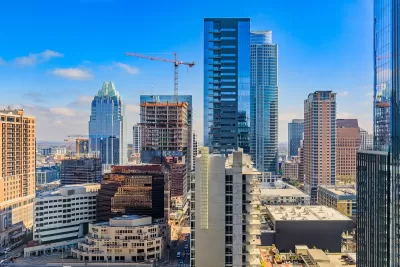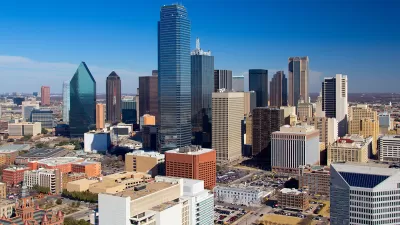Thanks to a construction boom, the city is no longer the most expensive housing market in Texas.

Rent prices in Austin, Texas have declined for a 19th straight month amidst a national housing crisis, reports Joshua Fetcher in Governing. “Surrounding suburbs like Round Rock, Pflugerville and Georgetown, which saw rents grow by double-digit percentages amid the region’s pandemic boom, also have seen declining rents.”
Experts attribute the drop in housing costs to a “massive apartment building boom” that brought tens of thousands of new housing units to the metro area. However, “It’s unclear how long the downward trend in Austin rents will last. While nearly 17,000 apartments are under construction, according to MRI data, builders have pulled back on new projects amid the glut.”
Skyrocketing costs during the pandemic led to a shift in policy, enabling zoning reform that allowed for more construction. However, rents remain roughly 17 percent above pre-pandemic levels, and almost half of the region’s renters spend more than 30 percent of their income on housing.
Landlords are also filing evictions at a higher rate than before the pandemic, and the number of unhoused people in Austin grew in 2024.
FULL STORY: After Skyrocketing, Rents in Austin Have Dropped 19 Straight Months

Trump Administration Could Effectively End Housing Voucher Program
Federal officials are eyeing major cuts to the Section 8 program that helps millions of low-income households pay rent.

Planetizen Federal Action Tracker
A weekly monitor of how Trump’s orders and actions are impacting planners and planning in America.

The 120 Year Old Tiny Home Villages That Sheltered San Francisco’s Earthquake Refugees
More than a century ago, San Francisco mobilized to house thousands of residents displaced by the 1906 earthquake. Could their strategy offer a model for the present?

HSR Reaches Key Settlement in Northern California City
The state’s high-speed rail authority reached an agreement with Millbrae, a key city on the train’s proposed route to San Francisco.

Washington State Legislature Passes Parking Reform Bill
A bill that would limit parking requirements for new developments is headed to the governor’s desk.

Missouri Law Would Ban Protections for Housing Voucher Users
A state law seeks to overturn source-of-income discrimination bans passed by several Missouri cities.
Urban Design for Planners 1: Software Tools
This six-course series explores essential urban design concepts using open source software and equips planners with the tools they need to participate fully in the urban design process.
Planning for Universal Design
Learn the tools for implementing Universal Design in planning regulations.
Ada County Highway District
Clanton & Associates, Inc.
Jessamine County Fiscal Court
Institute for Housing and Urban Development Studies (IHS)
City of Grandview
Harvard GSD Executive Education
Toledo-Lucas County Plan Commissions
Salt Lake City
NYU Wagner Graduate School of Public Service





























